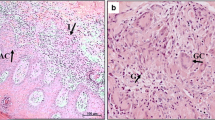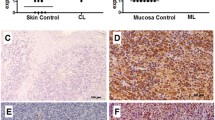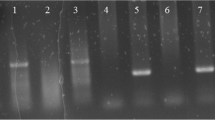Abstract
Cutaneous leishmaniasis (CL) is an infectious disease caused by Leishmania parasite. The expression of inducible nitric oxide synthase (iNOS) and generation of nitric oxide in response to IFN-γ and TNF-α is important in control of infection. The aim of the study was to determine the expression of iNOS in the lesions of Leishmania tropica, and whether there was a correlation between the level of expression and the duration of the disease. Punch biopsy was performed from patients (n = 29) and iNOS immunohistochemical staining was applied. Expression of iNOS protein was detected 82.8% of patients. There was a strong expression with the duration of the disease less than 6 months (p < 0.002). These findings demonstrate that iNOS has a role in L. tropica especially during the early stages of the infection. (Mol Cell Biochem xxx: 147–149, 2005)
Similar content being viewed by others
References
Herwaldt BL: Leishmaniasis. Lancet 354: 1191–1199, 1999
Pearson RD, Sousa AQ: Clinical spectrum of leishmaniasis. Clin Infect Dis 22: 1–13, 1996
Ok UZ, Balcı oglu İC, Ozkan IT, Ozensoy S, Ozbel Y: Leishmaniasis in Turkey. Acta Tropica 84: 43–48, 2002
Ritter U, Moll H: Monocyte chemotactic protein-1 stimulates the killing of Leishmania major by human monocytes, acts synergistically with IFN-γ and is antagonized by IL-4. Eur J Immunol 30: 3111–3120, 2000
Brunet LR: Nitric oxide in parasitic infections. Int Immunopharmacol 1: 1457–1467, 2001
Gantt KR, Goldman TL, McCormick ML, Miller MA, Jeronimo SMB, Nascimento ET, Brintigan BE, Wilson ME: Oxidative responses of human and murine macrophages during phagocytosis of Leishmania chagasi. J Immunol 167: 893–901, 2001
Stenger S, Thuring H, Rollinghoff M, Bogdan C: Tissue expression of inducible nitric oxide synthase is closely associated with resistance to Leishmania major. J Exp Med 180: 783–793, 1994
Diaz NL, Fernandez M, Figueira E, Ramirez R, Monsalve IB, Tapia FJ: Nitric oxide and cellular immunity in experimental cutaneous leishmaniasis. Clin Exp Dermatol 28: 288–293, 2003
Liew FY, Li Y, Millott S: Tumor necrosis factor (TNF-alpha) in leishmaniasis. II. TNF-alpha-induced macrophage leishmanicidal activity is mediated by nitric oxide from l-arginie. Immunology 71: 556–559, 1990
Qadoumi M, Becker I, Donhauser N, Rollinghoff M, Bogdan C: Expression of inducible nitric oxide synthase in skin lesions of patients with American cutaneous leishmaniasis. Infect Immunol 70: 4638–4642, 2002
Yaman M, Ozbel Y: The sandflies (Diptera: Psychodidae) in Turkish province of Hatay: some possible vectors of the parasites causing human cutaneous leishmaniasis. Ann Trop Med Parasitol 98: 741–750, 2004
Bogdan C, Rollinghoff M, Diefenbach A: Reactive oxygen and reactive nitrogen intermediates in innate and specific immunity. Curr Opin Immunol 12: 64–76, 2000
Erel O, Kocyigit A, Bulut V, Gurel MS: Reactive nitrogen and oxygen intermediates in patients with cutaneous leishmaniasis. Mem Inst Oswaldo Cruz 94: 179–183, 1999
Serarslan G, Yı ldı rı m HR, Sogut S: Serum antioxidant activities, malondialdehyde and nitric oxide levels in human cutaneous leishmaniasis. Clin Exp Dermatol 30: 267–271, 2005
Niedbala W, Wei XO, Piedrafita D, Xu D, Liew Y: Effects of nitric oxide on the induction and differentiation of Th1 cells. Eur J Immunol 29: 2498–2525, 1999
Berman JD: Human leishmaniasis: clinical, diagnostic, and chemotherapeutic developments in the last 10 years. Clin Infect Dis 24: 684–703, 1997
Herwaldt BI, Berman JD: Recommendations for treating leishmaniasis with sodium stibogluconate (Pentostam) and review of pertinent clinical studies. Am J Trop Med Hyg 46: 296–306, 1992
Buates S, Matlashewski G: Treatment of experimental leishmaniasis with the immunomodulators imiquimod and S28463: efficacy and mode of action. J Infect Dis 179: 1485–1494, 1999
Author information
Authors and Affiliations
Corresponding author
Rights and permissions
About this article
Cite this article
Serarslan, G., Atik, E. Expression of inducible nitric oxide synthase in human cutaneous leishmaniasis. Mol Cell Biochem 280, 147–149 (2005). https://doi.org/10.1007/s11010-005-8542-3
Received:
Accepted:
Issue Date:
DOI: https://doi.org/10.1007/s11010-005-8542-3




